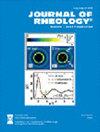纤维素纳米纤维对 Pickering 乳液行为的影响。第二部分:触变性和动态力学测试
IF 3
2区 工程技术
Q2 MECHANICS
引用次数: 0
摘要
皮克林乳液的非线性流变学用于进一步研究内部结构的非线性和不可恢复的转变,这种转变超出了微小结构扰动的线性粘弹性机制。探索各种流变学方法在乳液应用中起着至关重要的作用,例如模拟静态和液态流动状态之间的宏观结构转变、应变超调以及断裂结构的再生。根据我们之前的研究,纤维素纳米纤维(CNFs)皮克林乳液是研究聚合物基乳液的典型体系,其辅助表面活性剂[十二烷基二甲基溴化铵(DDAB)]可增强 CNF 的吸收。为了进一步研究不同 CNF 或 DDAB 含量带来的不同流变特性,采用了多间隔触变试验、大振幅振荡剪切和浓度-时间相关叠加等方法来研究线性粘弹性和非线性范围的结构转变。这项研究是在之前发表的作品 [Cui 等,材料 15,8285 (2022)]基础上进行的,是对同一样品系列的进一步表征。本文章由计算机程序翻译,如有差异,请以英文原文为准。
Influence of cellulose nanofibers on the behavior of Pickering emulsions. Part II: Thixotropy and dynamic-mechanical tests
Nonlinear rheology of Pickering emulsions is used to further investigate the nonlinear and unrecoverable transformation of inner structures, which is beyond the linear viscoelastic regime of tiny structural disturbances. Exploring various rheological methods plays a vital role in emulsion applications, such as simulating the macroscopic structural transformation between static and liquidlike flow states, strain overshoot, and regeneration for broken structures. According to our previous studies, cellulose nanofibers (CNFs) Pickering emulsions are a typical system for investigating polymer-based emulsions with the auxiliary surfactant [didodecyldimethylammonium bromide (DDAB)] for enhancing CNF absorption. To further study different rheological properties by varying CNF or DDAB contents, multiple interval thixotropic test, large amplitude oscillatory shear, and concentration-time-dependent superposition are employed to study the linear viscoelasticity and structural transformation of nonlinear range. This research was conducted based on the previous published works [Cui et al., Materials 15, 8285 (2022)] as a further characterization for the same sample series.
求助全文
通过发布文献求助,成功后即可免费获取论文全文。
去求助
来源期刊

Journal of Rheology
物理-力学
CiteScore
6.60
自引率
12.10%
发文量
100
审稿时长
1 months
期刊介绍:
The Journal of Rheology, formerly the Transactions of The Society of Rheology, is published six times per year by The Society of Rheology, a member society of the American Institute of Physics, through AIP Publishing. It provides in-depth interdisciplinary coverage of theoretical and experimental issues drawn from industry and academia. The Journal of Rheology is published for professionals and students in chemistry, physics, engineering, material science, and mathematics.
 求助内容:
求助内容: 应助结果提醒方式:
应助结果提醒方式:


